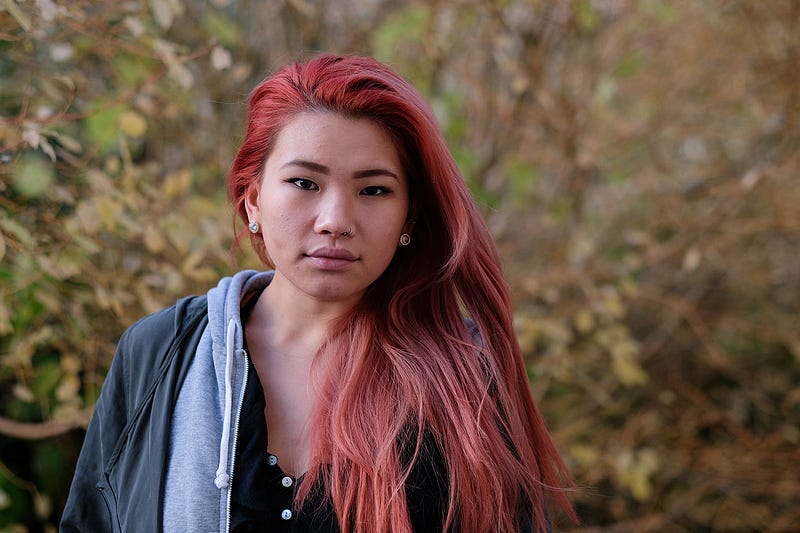Stuck in the Middle

As an adopted Chinese-American woman, I live a life in the gray area
Personal narrative written by Hallie Fuchs // Photo by Jake Tull
When I was younger, I went to a Jewish school in Manhattan where I was one of two Chinese students. We were both adopted by Jewish parents and raised in the faith. I didn’t realize that we were different from our counterparts. People would ask what I was and I would tell them “I’m part German, Polish and Russian,” because that’s what my mom is. I kid you not, I thought I was German.
I’m not German. I was born in China — I have slanted brown eyes and black hair that I would try to dye with Sun-In. My mom is short and Caucasian with green eyes and light brown hair.
China created its first adoption law allowing foreigners to adopt children in 1992. I was adopted in 1994. According to the U.S. Department of State, I was one of 787 children, mainly girls, adopted that year. Since then, it’s been upwards of 60,000.
There aren’t many Chinese adoptees in their early twenties. It’s hard to relate to others — I still don’t totally understand myself or the psychological component that comes with adoption.
According to the Child Welfare Information Gateway, adopted children score lower in areas like self-esteem and self-confidence. With international Chinese adoption being relatively new, the impact on children in terms of identity or lack thereof hasn’t been studied.
With all its ups and downs, adoption is a beautiful thing. But you must look at the big picture, not just the idyllic selfless saving. There’s trauma — emotions are raw and gritty, some triggered by hearing, “She’s not your real/natural mom,” or “You’re so lucky that you were adopted.”
I am not speaking negatively about adoption. However, it has been romanticized: the hero, typically a white family, saving a poor, third-world child in need. It creates an expectation that only harms adoptees and their families.
My mother, brother and I moved to Washington state after Sept. 11, 2001, where my identity, formed in the face of tragedy, was solidified. I was a New Yorker where diversity was nothing new. Even at such a young age after the horror when the twin towers came to the ground, I felt affected by the sense of community and patriotism.
So I, this Chinese-Jewish girl with a fierce love for a state on the East Coast and a bad haircut, moved to Bellevue, Washington. I moved four times after that, ending up in Bellingham, Washington, for college and still not much has changed. I know a handful of people of color, including myself, and even less who are adopted.
In 2014, former president of Western Washington University Bruce Shepard said we needed to diversify the campus. He wasn’t wrong. In a sea of white, my black hair and yellow-tinted skin stands out fairly well. According to Western’s Student Diversity Statistics, the fall of 2016 saw a record-high enrollment and student retention of minorities at 25.3 percent. I represent the 25.3 percent.
From being called a Twinkie, to a banana (meaning white on the inside, Asian on the outside), to the “most non-white, white girl I’ve ever met,” people completely disregard the complex parts of my identity. Does the fact that I was raised by a white mother in a white community make me a race traitor? I’m not actually white, but am I trying too hard to be?
Race has always been a sensitive subject. As we speak, the media is showing police shooting young black men and a president-elect who wants to build a wall along the Mexican border. It feels like a race war. Where do other minorities, especially Asian-Americans, fit in?
My racial identity issues come through microaggressions not only from other Asian people, but from my white peers. They seem to pale in comparison to what other minorities go through. Are mine still valid? Every Asian person has heard, “Your face is flat,” “How do you blindfold an Asian? You use dental floss!” or the great, “No, where are you really from?”
Sometimes I forget I’m a person of color because I attribute my attitude and personality to whiteness. Yet, I’ll get the constant reminder from my peers and strangers that no, I am not white.
A study done by the Journal of Community Health reported that 1,130 Korean-Americans between the ages of 18–29 suffered negative mental health outcomes due to the pressure of understanding their Korean background, while also minimizing those same values to adapt to American culture.
As a model minority, we acclimate to white culture the best, we get the most prestigious jobs, and we don’t put up a fight. Docile, effeminate, kowtowing to white America.
These studies are only on Asian-Americans whose families have immigrated from Asia. As someone who is adopted, it feels semi-applicable. My family celebrates Chanukah and ate “authentic” food from Chinatown when we lived in New York. I signed up for karate, tap and ballet just like my white peers, but also took Chinese lessons, which I failed at miserably. My Chinese peers automatically learned the language, ate Chinese food at home and no, they didn’t celebrate Chanukah.
My identity makes me unique and somewhat of an anomaly. I have never met another person with a similar story. It’s like the Scottish-Korean Starburst commercial that aired several years ago — the “walking contradiction.” Even though throughout my life I have felt the brunt of racism either by not being white enough or Asian enough, I’m proud to bring a new perspective of what it means to be an American woman.
